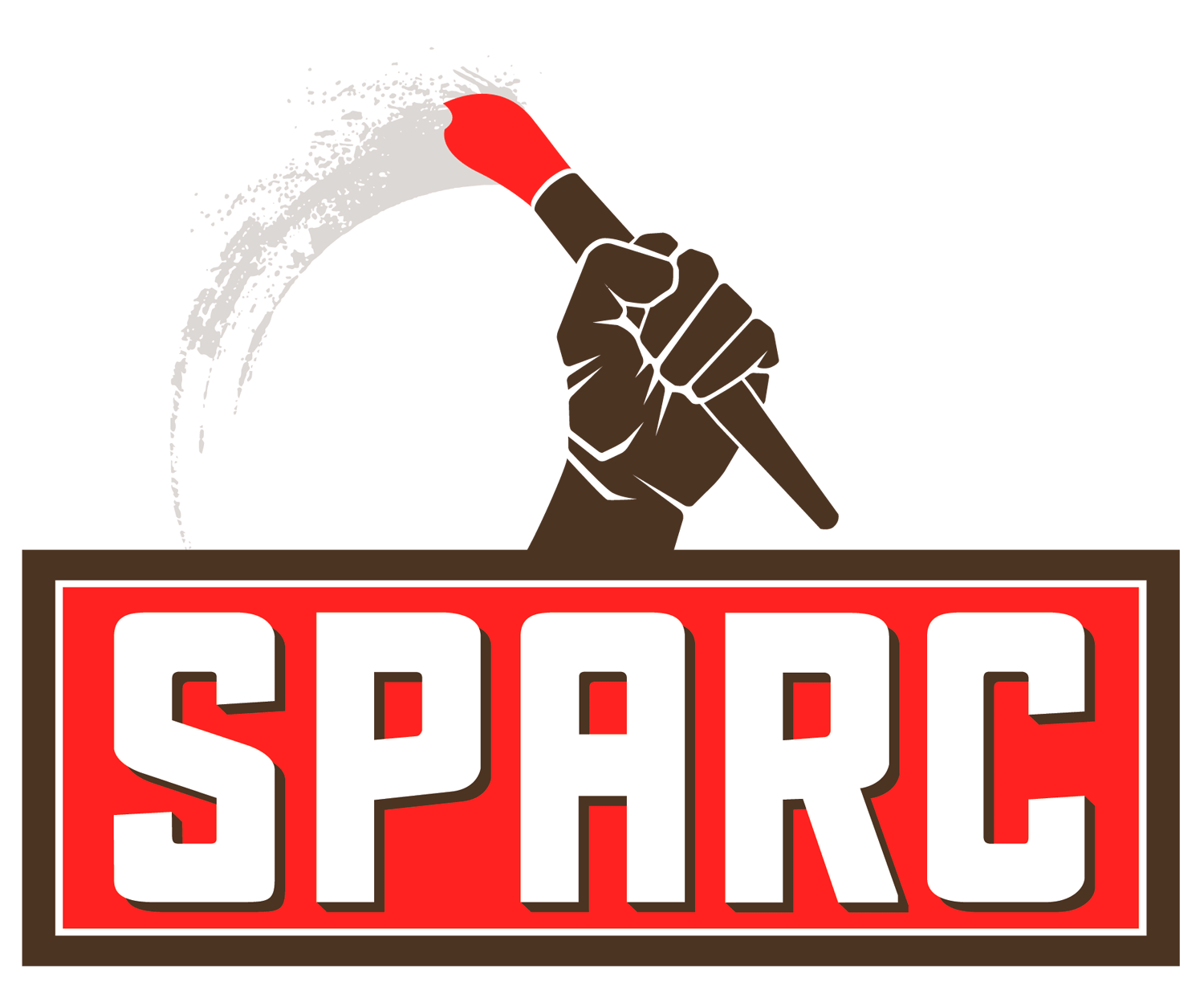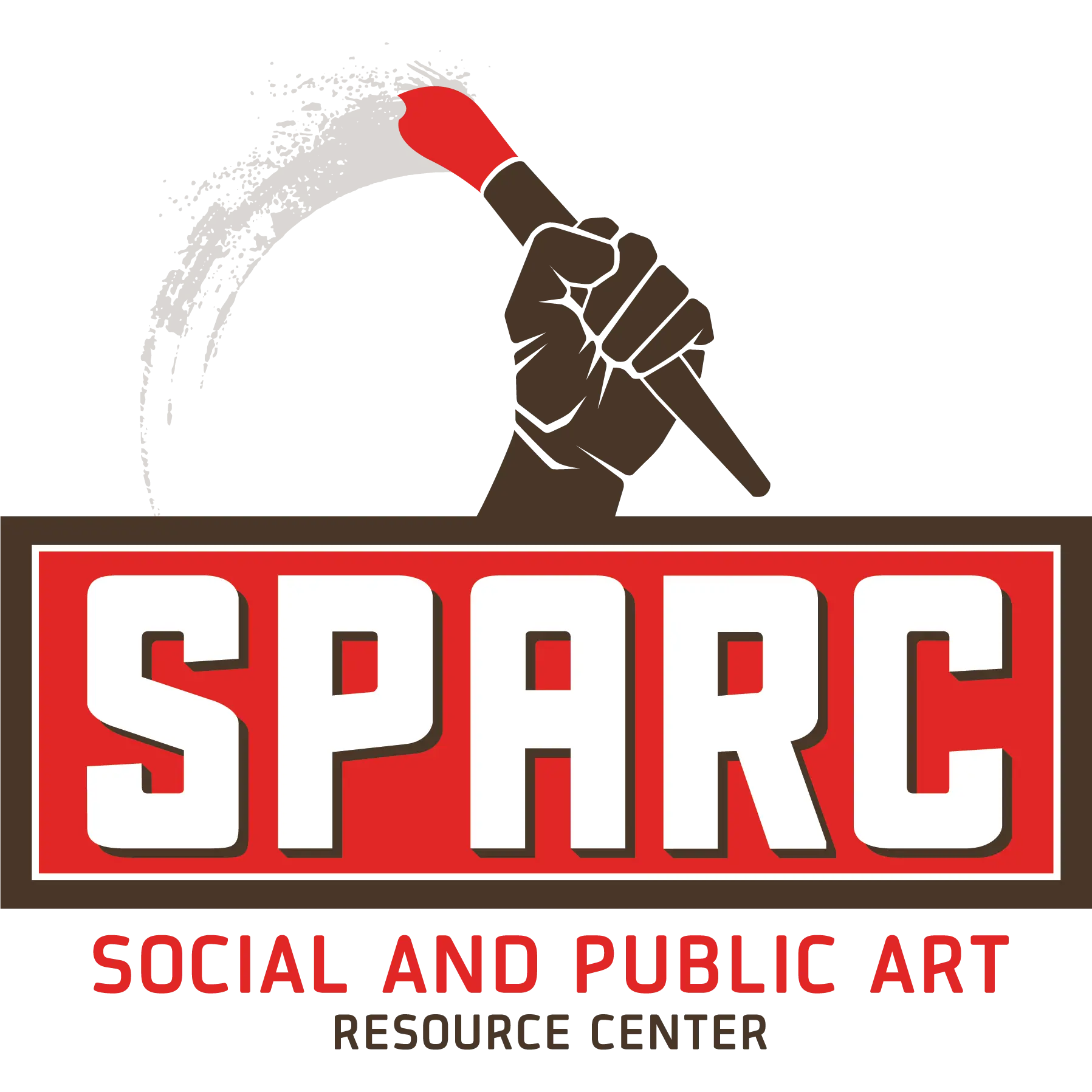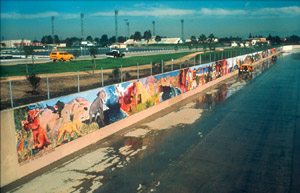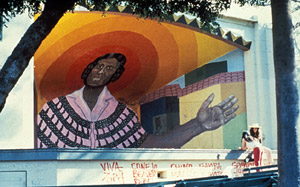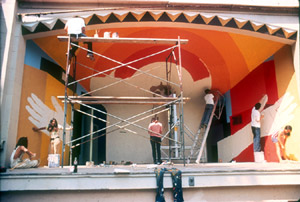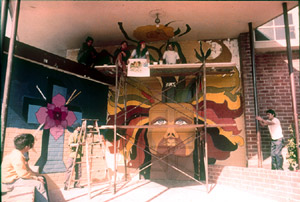Brief History
The seed of SPARC’s vision is the Mexican social mural movement, especially as expressed by David Alfaro Siqueiros: “We repudiate so-called easel art and all such art which springs from ultra-intellectual circles, for it is essentially aristocratic. We hail the monumental expression of art because such art is public property.” What follows below is an abridged form of an article by SPARC’s Artistic Director and Founder, Professor Judith F. Baca, written in 2001, entitled Birth of a Movement. In the article she describes how the ideals of the Mexican social mural movement inspired Los Angeles muralists in the 1970’s and how her work painting murals with at-risk youth formed the basis of the first city-wide mural program and eventually led to the creation of SPARC.
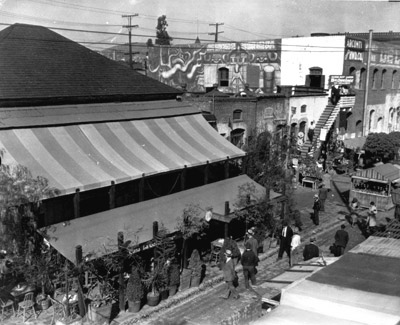
Birth of a Movement
Perhaps it was the abundance of concrete, or the year-round painting season, or the city full of Mexican workers that made Los Angeles the place where murals began to be a predominant art form. Or perhaps it was because an entire population — the majority of the city — had been “disappeared” in textbooks, in the media, in cultural markers of place, and needed to find a way to reclaim a city of Mexican and indigenous roots.
In 1932 a mural was painted on Olvera Street, the birthplace of Los Angeles, by the great maestro David Alfaro Siqueiros, the Mexican muralist/painter. Siqueiros was the last of Los Tres Grandes (The Three Great Muralists), who after the 1910 revolution in Mexico began a cultural revolution that taught the precepts of the revolution and the history of Mexico through murals. Siqueiros, the most revolutionary of the three in materials usage, social intent and content, worked for a period of time in Los Angeles. His 80-foot-long mural America Tropical spoke to the exploitation of the Mexican worker. Commissioned by the city fathers for a Bavarian beer garden (owned by a Nazi), the mural was intended to depict a kitschy Mexican village scene for the benefit of tourists. Instead, Siqueiros made the central image of the mural a crucified figure.

With increasing demand for low-wage immigrant labor and massive migrations of Mexican and Central American workers to Los Angeles over the last 10 or 15 years, this image is even more relevant today than in the ’30s. The mural was partially whitewashed shortly after its completion and then fully painted over within its first year on public view beginning a legacy of censorship that still haunts Los Angeles. In the 1970’s, forty years after it was painted over, the image began to reemerge from the whitewash. We saw this as a symbol, an aparicion (religious apparition), coinciding with the growth of Los Angeles’s Mexican population and strength of the Chicano movement.
LA Murals Origin
Murals in Los Angeles were the first artistic medium to support and then shape a movement toward identity and justice that reached a mass population. This artistic occupation of public space forged a strong visual presence of a people who at that time (late ’60’s, early ’70s) lacked representation in public life, with neither voice in elections, nor elected representatives. No person of Latino descent served on the City Council or on the School Board, despite the fact that in actual numbers we were fast becoming the majority of the population. Parallel to and perhaps growing from this new visual strength, many citizens of emerging Latino communities organized, with very little money and freely given labor, toward the mutual goal of improving the conditions of their communities. While many of the early Chicano Muralists were the first generation with advanced degrees in their communities, a racially unsophisticated society, tied the Chicano artist to the conditions of the barrios or Latino neighborhoods regardless of their educational status. SPARC was born of the spirit of this movement, taking its name from the notion that it takes only a spark to start a prairie fire. The organization has been intent on nurturing this healthy fire within the city as a whole for nearly 40 years.
As the fire of muralism progressed distinctions began to emerge. Apart from its initial purpose of creating a capacity for the imagery of the people to occupy public space, Los Angeles murals spoke to the cultural demands of previously under-represented peoples. Some works became cultural-affirmation images, asserting only that we exist as distinct cultures; others addressed the hard task of articulating and advocating for resolution of issues affecting the places where our people lived and worked.
This new social power was not limited to immigrant labor nor indigenous people but spread to the multiplicity of Los Angeles populations. African American, Thai, Chinese, Jewish and women’s murals began to appear on the streets of Los Angeles. Before long, community murals began to attract media attention and documentation. Murals began to tackle larger issues of police brutality, border crossings, drug addiction, gang warfare, and other difficulties of a life of poverty and exclusion. Early in the movement space was freely available and uncontested. If you had the paint and the time, the wall and the message were yours. In this environment the movement flourished. In the early seventies a visitor could drive from site to site and could have seen Carlos Almaraz, David Botello, Willie Herron, and I all painting simultaneously on the streets of Los Angeles.
In 1970, I began working for the Los Angeles Department of Recreation and Parks, teaching art in Boyle Heights, a neighborhood with the highest number of gangs in the United States. Similar to the neighborhood I grew up in (Pacoima), Boyle Heights had cultural markers — graffiti —with roll calls written on the walls that told you who lived there, what the neighborhood was called and who was from there. But this stylized iconography often triggered destructive conflict, part of the contesting of public space by rival gang members. I began working with gang members from different neighborhoods to establish networks between them to promote peaceful solutions to such conflicts. Redirecting gang members’ inclinations toward public expression via my own artistic training as a painter, we began painting murals as a way to create constructive cultural markers.
One day as we were painting I came face-to-face with the General Manager of the Department of Recreation and Parks, Sy Greben. He had recently taken that job after having served as the Director of the Peace Corps for President John F. Kennedy’s administration. He asked, “Are you being paid to do this work?” Since Mr. Greben was the highest-ranking person in the department, I was afraid to answer for fear that not having official status as city employees, our painting of park walls would be halted. “No,” I said politely, “I am an art teacher in your parks working on my own time.”
BRIEF HISTORY
Mr. Greben understood the power and importance of what he witnessed that day in the cooperate spirit of the young painters. He began a course of action that led to the first City of Los Angeles city-wide mural program, making me director of a burgeoning murals program in the predominantly Mexican Eastside of Los Angeles. Freed from my more conventional teaching by the General Manager, I began to work full-time with the youth of East Los Angeles called by neighborhood youth to work at various sites. Three years later, I initiated a proposal to the Los Angeles City Council that became the first city-wide mural program. More than 400 mural productions were supported through the Citywide Murals Program under the Department of Recreation and Parks before the program was disbanded. Scaffolding, paints, youth apprentices and stipends were distributed by the small staff of Eastside youth from previous mural crews whom I hired to run the program, supporting hundreds of mural sites in every community of the city.
Within the first year of the Citywide Murals Program, censorship problems arose as communities began to identify issues affecting their lives. Because the program was under the auspices of a City department, local officials tried to exert influence on works that were created within their districts, threatening to withhold funds for the entire citywide program under their purview. One council member, realizing the popularity of the murals, asked to have his own portrait painted on a highly visible public street to help ensure his re-election. Controversies continued to arise, of course, and interestingly the themes that provoked outrage from officials and conservative elements of our city remain controversial today.
It was for this reason that the “Friends of the Citywide Mural Program,” a group of supporters including attorneys, called to defend the often-besieged program, decided to form a nonprofit corporation called the Social and Public Art Resource Center. In collaboration with members of the City Council who felt that freedom of speech was essential for the expanding mural movement, they encouraged the founding of SPARC as an arts organization that could carry out mural programs in such a way as to animate public discourse and free expression of the diverse communities of the city without direct official intervention.
The first project of the new nonprofit organization the Social and Public Art Resource Center was the Great Wall of Los Angeles mural and the rest is SPARC history…
